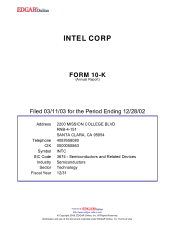Intel 2002 Annual Report Download - page 8
Download and view the complete annual report
Please find page 8 of the 2002 Intel annual report below. You can navigate through the pages in the report by either clicking on the pages listed below, or by using the keyword search tool below to find specific information within the annual report.
5
In the market segment for handheld computing devices, we sell flash memory, baseband chipsets and processors to OEMs of cellular
handsets. For OEMs of PDAs, we offer flash memory and processors. Growth in this market segment is dependent on the increased use of
handsets with more features and data-intensive applications.
At the heart of our wireless product strategy is the Intel® Personal Internet Client Architecture (Intel® PCA), an open architecture platform
that describes the separation of communication and application building blocks for data-enabled cellular phones and portable handheld devices.
By separating the communication and application elements within a device, Intel PCA allows for faster time-to-market for our customers and a
standard, scalable platform for application development.
Net revenue for the Wireless Communications and Computing Group operating segment made up approximately 8% of our consolidated net
revenue for 2002.
Flash Memory
Flash memory is a specialized type of memory component used to store user data and program code; it retains this information even when
the power is off. Although flash memory is currently used predominantly in mobile phones and PDAs, it is also found in common consumer
products, including MP3 music players, handheld voice recorders and digital answering machines, as well as industrial products. In the first
quarter of 2002, we began shipping the industry's first flash memory built on the 0.13-micron manufacturing process technology. This new flash
chip, the 32-Mb Advanced+ Boot Block flash chip, is nearly 50% smaller and consumes less power than its 0.18-micron predecessor, making it
ideal for cell phones and other electronics equipment for which small form factor and low power consumption are critical.
In April 2002, we introduced the Intel® Wireless Flash memory at 1.8 volts, running up to four times faster than previous flash solutions.
These flash memory products increase the performance of data-intensive Internet phone applications such as browsing, streaming multimedia
and text messaging.
Our Intel StrataFlash® memory technology provides a cost-effective, single-chip solution for code execution and data storage. In
October 2002, we introduced the Intel StrataFlash® Wireless memory, the world's first 1.8-volt multi-level cell flash memory on industry-
leading 0.13-micron process technology. The new product is the first to combine wireless performance features with Intel StrataFlash
technology, doubling the number of bits in a single memory cell (multi-level cell) for higher performance and greater data storage for wireless
devices. It is the first multi-level cell memory to run at 1.8 volts, the lowest in the industry.
Processors for Handheld Computing Devices
The Intel XScale microarchitecture, offering low power consumption and fast clock speeds, enables a new generation of handheld and
cellular devices, as well as wireless smart displays. Smart displays are wireless flat-panel displays that are used as monitors when docked to a
base desktop PC, but when detached become a mobile monitor using 802.11 industry standard wireless technology. In February 2002, we
introduced the Intel® PXA250 and PXA210 chips, designed to enable mobile phones and handheld computing devices to deliver music, video
and computer games. In March 2002, we introduced extended temperature versions of the Intel PXA250 and Intel PXA210 application
processors for use in telematics terminals in cars, to provide services such as roadside emergency assistance, navigation systems, integrated
hands-free cellular phones, and multimedia entertainment and information systems.
In September 2002, we introduced Intel® Wireless MMX™ technology for the Intel PCA architecture, designed to bring desktop-like
multimedia capabilities to wireless and handheld products based on Intel PCA.
In October 2002, we introduced "system-in-a-package" technology in the form of the Intel® PXA261 and PXA262 microprocessors,
designed for data-enabled wireless handsets based on Intel PCA. These processors place an Intel XScale technology-based processor directly on
top of Intel StrataFlash memory chips in a single package.
Cellular Baseband Chipsets
We offer baseband chipsets for designing multi-mode, multi-band wireless handsets. Our chipsets support multiple wireless standards and
deliver enhanced voice quality and high integration, while reducing power consumption and costs. We offer the Intel® D5205 TDMA Baseband
Chipset, a compact two-chip solution, and
6
the Intel
®
5206 TDMA Baseband Chip, a compact single
-
chip solution, both for dual
-
mode cellular and Personal Communication Services





















